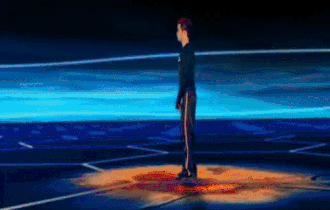Released: 28th August 2000
Writers: Pål Waaktaar / Magne Furuholmen / Morten Harket
Peak position: #1
Chart run: 1-4-13-21-27-32-49-52-60-72-X-X-69
Despite proving themselves as competent songwriters on their debut album, a1 were yet to score a #1 single. So, their record label came up with a surefire way to remedy that for the follow-up: a cover of Take On Me.

Of all the late-’90s/early-’00s pop acts whose biggest hit (in sales terms, at least) ended up being a cover version, a1 were probably among those who least deserved that to be their legacy. Or it was – at least – very misrepresentative. Though they were marketed as a fairly traditional boyband of the era, the group wrote or co-wrote 10 of the 12 tracks on their debut album, Here We Come and played their own instruments. The early singles they released didn’t necessarily showcase such talents because the desire – nay, necessity – from audiences for them to do so wasn’t there yet. Even so, resorting to a cover as the introduction to a1’s second album felt like it was doing the group a bit of a disservice. And yet, begrudgingly, choosing Take On Me was a great idea from Columbia Records. The track was a massive hit in 1985 for a-ha, reaching #1 in many countries – including America – and #2 in the UK. Its success was partly propelled by an award-winning music video that used rotoscoping to blend live-action and pencil-sketch animation.

Picking such a well-known song immediately put a1 on the radar. It’s not as if the group wasn’t popular: four consecutive top ten singles and a gold-certified debut album were evidence enough of that. Even so, their presence could still have passed by more casual fans, given how fiercely competitive the market was. Of course, a cover in itself wasn’t necessarily going to change that; but this one had the sort of stature that would provoke a response, which is exactly what a1 needed.

Sensibly, there isn’t any considerable attempt to change Take On Me; it essentially hits all the same beats as the original, and that’s entirely the right approach. The song’s enduring appeal is based on two distinctive elements: the distinctive synth riff and the falsetto note in the chorus. There’s much more to the track besides, but those bits need to happen and can’t be messed with in any significant way. So, the main difference is on the production side, where there is room to be more resourceful. This version of Take On Me is set against the backdrop of the digital revolution, and it steers much of the single’s identity. Adding an electro-tinged bassline gives the tracka fuller sound, while whooshing and whirring effects – vaguely reminiscent of a dial-up internet connection – occur intermittently. Even the liberal use of vocoder comes off as being stylistically driven rather than compensating for shortcomings.

Yet, as much as this is an intentional update of Take On Me designed to appeal to the ’00s pop audience, it’s handled with care and respect for the source material so that none of the changes are intrusive to the core of the song. As soon as the first verse starts: “Talking away, I don’t know what… I’m to say, I’ll say it anyway, today’s another day to find you, shine away… I’ll be coming for your love okay” it becomes apparent there’s no deviation from the established melody, and a1’s delivery evokes a rousing thrill that isn’t far from the original at all. Inevitably, taking a lead vocal initially performed by one person and then splitting it four ways means Take On Me loses a bit of conviction. But everything else remains intact, including the dizzying mid-track instrumental. It still runs for 30 seconds – which is quite unusual for turn-of-the-century pop music – and remains utterly exhilarating.

But of course, the question is whether a1 – specifically, Ben Adams – can pull off the chorus: “Ta-a-ake o-o-on m-e-e-e (take ON me), ta-a-ake m-e-e-e o-o-on (take ON me), I’ll…b-e-e-e…go-o-o-one…in a day or TWO-O-O-O-O-O-O-O”. And he can when Take On Me gives him a chance to. At first, it seems the intention is to obscure the falsetto with production, to the extent that his voice gets filtered and turned into electronic beeping during the second chorus. However, the final minute is much cleaner, and it’s good. It’s very good. Indeed, some of a1’s more recent live performances show how Ben Adams has further stamped his own style on the song, which isn’t an easy task when Morten Harket set the benchmark. Though that individuality isn’t quite so clearly defined here, Take On Me still does precisely what it needs to in delivering that big note which is impossible not to sing along with.

Columbia Records had little choice but to pull out the stops for the music video given how ground-breaking a-ha’s had been. The song has such a strong visual identity that a similar effort had to be expended. Furthermore, if the label was going to shift perceptions about where a1 sat in the chart landscape (tellingly, their second album was titled The A List), then Take On Me had to look the part. And it did; extravagantly so. Purportedly one of the most expensive videos made in the UK at that point, it features the group battling a computer virus that is bringing down global stock markets. After donning virtual reality visors, a1 appear inside a Tron-esque digital environment and – aided by a woman who controls their powers using a CD-ROM drive – chase down the virus before destroying it.

There’s always the risk that cutting-edge technology will quickly show its age, which is true to a certain extent with Take On Me (some of the equipment seen is already obsolete). However, it’s still possible to watch the video and appreciate what this represents. a1 were not an act who had access to million-pound budgets, so to see them flying through cyberspace, dashing up walls, flipping head over heels or doing the bullet time dodge from The Matrix – and for it to come even close to movie standard – is incredibly impressive. Moreover, there’s such a strong association between how Take On Me looks and sounds that it’s hard to separate the two as they appear to have influenced one another.

As a cunning plan to push a1 to the next level, Take On Me could scarcely have gone better. The track sold 82,000 copies to debut atop the chart, improving on the original peak achieved by a-ha in the UK. And despite an overall total of 205,000, making it one of the lower-selling singles to reach #1 in 2000 (placing it 59th on the year-end chart), that was of little consequence. The group had scored their biggest hit – regardless of the margins – and pushed themselves a little closer to being seen among the frontrunners of pop music. It might have taken a cover to put them there, but if that meant a1 now commanded a little more attention, then it wasn’t necessarily a bad thing.

And ultimately, though Take On Me was – in pure chart terms – the group’s most successful single, it could never become synonymous with them due to the enduring popularity of a-ha’s version. As such, a1 were able to capitalise on the song as an enjoyable update of a classic without it overshadowing anything else they might do subsequently. Indeed, it wouldn’t be too long before they demonstrated what they were capable of in their own right…



